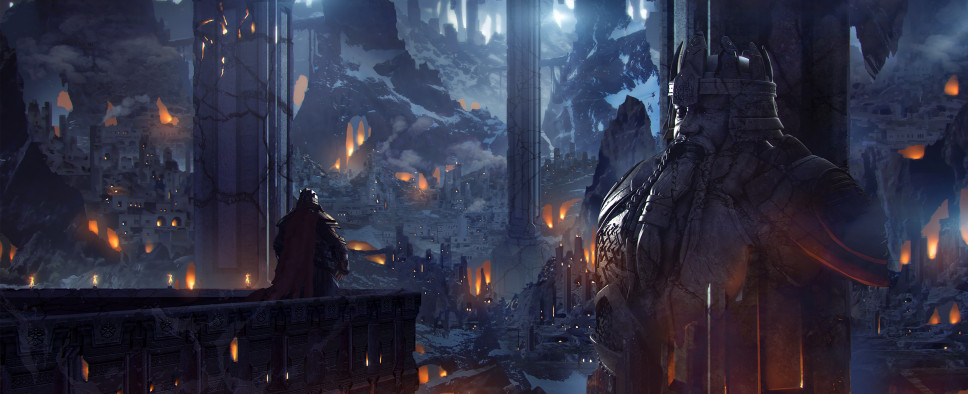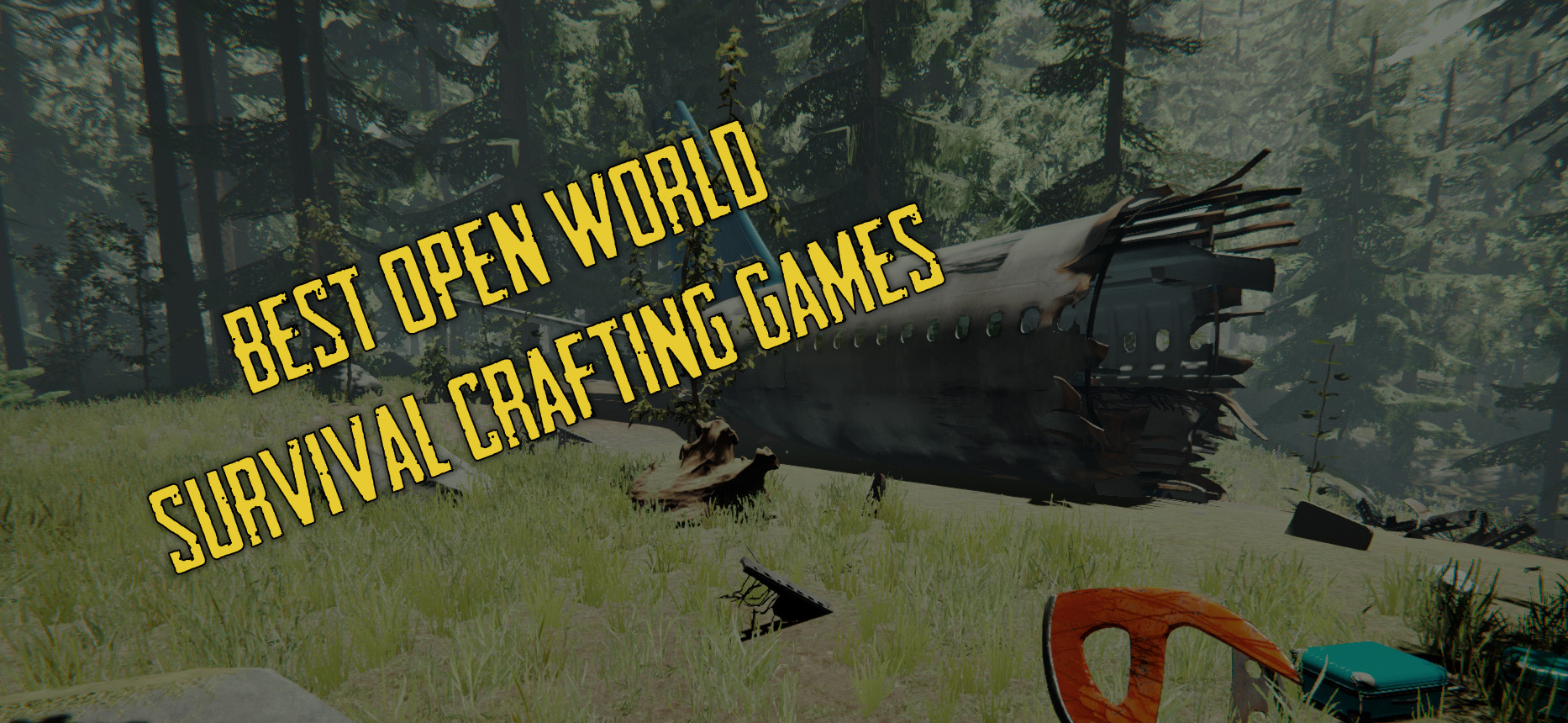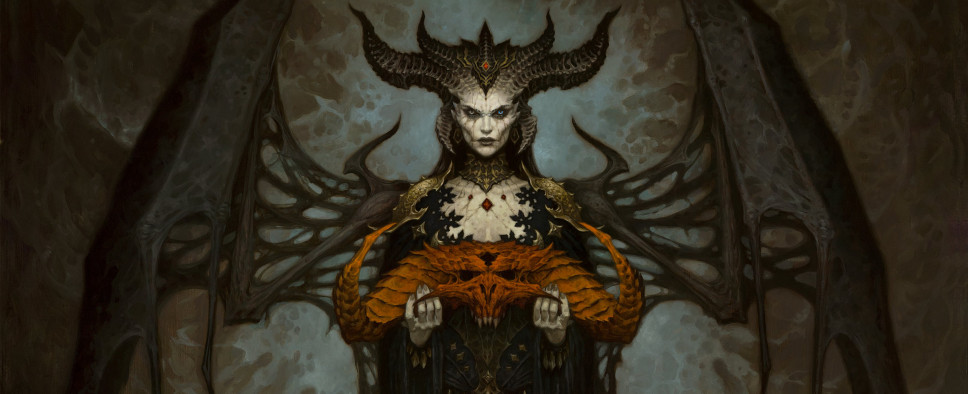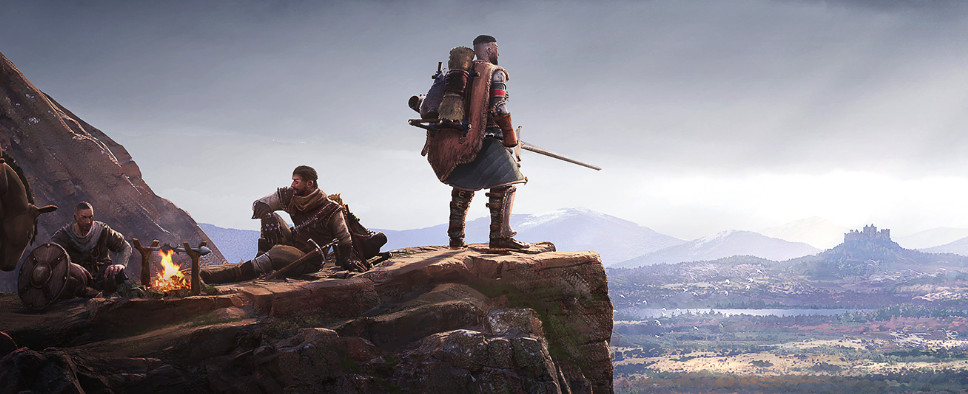In our previous Development Updates, we’ve had the chance to talk about many different topics such as animation, VFX, narrative, and more, explaining our approach to Alaloth’s development so far. Now it’s time to talk about music and sound design! A variety of epic games and movies inspired us in many different ways so we wanted to share how our audio team approached the challenge of bringing our huge RPG world to life.
The Blessed Kingdom of Edherest
To create the loops for areas in Edherest, we found inspiration from the lore description of each city, their aspects and inhabitants, as well as from other great video game soundtracks. We started with the main theme, improvising a melody with the idea that this was for the ‘capital city’. Then, we added some basic harmony, following the root key. What came next was the tricky part. In fact, it was not easy to create six different variations (based on the city lore and appearance) because it could be easy to fall into repetitions resulting in the tracks being a bit boring. Therefore, while staying faithful to the theme, we decided to use different rhythms and changed instruments’ timbre to get around the problem.
- Goldport [Main Theme]: Solemn and epic music, with a dark and medieval melody. All variations must follow the melody. It starts with theme presentation (string section only), and goes through to the climax with percussion and brass sections.
- Winterleaf: A very dark track with only a string section and viola. The first part of the theme is with a cello; the second part is with the string section.
- Baystone: Creates a shady and mysterious mood using only a dulcimer. Very rhythmic with bass; melody goes “crescendo”.
- Coldwood: Similar to the main theme. The brass section introduces the melody, then percussion and string sections in “crescendo”.
- Mayfalls: A soft mood, due to the presence of nature sounds and the presence of a waterfall. String and expressive flute.
- Westwall: A “military” mood, ready for war. Great importance to the brass and percussion sections.
- Whitewind: Similar to the mood of Winterleaf. String section and two cellos that overlap each other.
The Republic of Larastir
In composing the main theme of Larastir and its variation cycles, we mostly read the description of the introductory lore for inspiration, trying to understand what kind of melody, harmony, and mood could fit its stories. The main external reference and inspiration came from The Lord of the Rings and elven music in general, although in this case, we preferred to improvise more. This led us to experience some challenges, especially with creating the variations, but by changing timbres, rhythm, and mood, we were able to come up with something we were pleased with.
- Thilaris [Main Theme]: Solemn music but creating a very magical atmosphere: horn and string sections and an emphasis on the choir, which fills the background. The string section dominates in the first part while the horn section dominates in the second
- Lindorwin: A sad and melancholy mood, but still solemn. Rhythm and harmony with the string section, while the melody is carried by the horn section. A choir in the background maintains a magical mood.
- Edhenen: A darker mood. The harp and horn section carry the melody with the “magic” choir in the background.
- Tirothas: Very rhythmic due to the connection between the elvish and dwarven races. Short violins and the horn section carry the melody with the ever-present choir in the background .
- Val’Rhain: An expressive flute and horn section symbolize a bow and arrow. Rhythm is carried by the string section and choir.
- Forlariath: A battle-ready mood, supported by the horn section. The string section and choir fill the background.
- Nir-Lathias: A secret and mysterious mood, with the harp and string section carrying the rhythm, and the choir singing a sort of melody.
[…]
The Expanse of Karak-Hohn
For Karak-Hohn, we started with the main theme, then moved to the variations, always reading into the kingdom’s intro lore description and taking a look at the cities’ design. The main reference was dwarven music from The Hobbit and The Lord of The Rings once again. It was a little tricky, especially with the melodies (the harmony needed to be in sync with the percussion), but got through it by changing rhythm.
- Khunden-Hohn [Main Theme]: A strong start with percussion and and the choir shouting to introduce the dwarves, the melody is carried by the horn and string sections. Always solemn.
- Bardushel: A bit of a battle mood, due to the ruling clan being here. Harmony with the percussion and choir shouting with the string section. Melody carried by the horn section.
- Naledzir: A secret kind of mood, with percussion and the choir shouting and a repetitive melody from the string section.
- Barran-Garr: Percussions with the choir shouting and a hammer-like sound. Harmony carried by the string section and melody by the horn section.
- Nhulbarar: A softer and slower mood, with percussion and the choir shouting. Harmony carried by the string section, melody by the horn section (first part low, second part high).
- Khuamun: A more rapid track, again with a hammer-like sound, and percussion and choir shouts. Melody carried only by the horn section, without a precise harmony.
- Kin’il’Nar: Very rhythmic, starting only with percussion and choir shouts. Then, in the first part, the melody is carried by the horn section (low); in the second part, low and high horn sections together.
The Desolation of Baga
To create loops here, we started from the description of the kingdom as usual and then moved to the cities’ lore description. As a main reference, we used orcish music from classic sources such as Warcraft and other titles. We tried to create something strong, but still solemn with not as fast of a rhythm as in other kingdoms. For the main theme, we chose the horn sections and percussion to be fundamental. For the six variations, we sometimes went a little far from the main theme to keep things interesting, but always followed the root key and musical scale, considering the double nature of Orcish people (we have savage orcs and citizens in Baga, living in a different way).
- Na’Nardur [Main Theme]: Aggressive and solemn. Trombones and percussion introduce the theme (a sort of oriental melody) this is followed by the horn section low and high and cellos and violas in the background. Crescendo of percussion.
- Hashak: Very solemn. Only the horn section with high and low; very rhythmic percussion.
- Gholuk: A dark mood. Introduction with the horn section and percussion (tuned to the horn section). The violas and cellos in spiccato create something dark and mysterious.
- Gashak: Similar to Hashak, due to the fact they are twin cities. It begins with trombones and then the horn section is added. Percussion again tuned with the melody.
- Ballek’Mahl: The introduction has the horn section and percussion doing the same pattern. Then trombones continue the melody, with cellos in the background. In the second part, percussion is always the same.
- Vhoken’Mahl: A darker mood. The same instruments of Ballek’Mahl, but percussion does a simpler pattern. More of a presence of the cellos in the background.
- Na’Kazkadden: A military and battle mood. Only percussion in the beginning, with two timpani. Then the low horn section introduces the melody, sustained by the high horn section in the second part.
Points of Interest
To create the loops for the Points of Interest around the Four Kingdoms, we took inspiration mainly from the aspect of the places and their descriptions. We also decided to improvise melodies and harmonies, even if our references were video games such as Witcher 3 and Skyrim. For every Points of Interest we followed the root key of the Kingdom’s loops and the same instruments, in order to be more coherent.
- The Sea of Stars: A very quiet and calm mood. The string section, with violins and cellos create the melody with doublebasses in pizzicato for the harmonic and rhythmic part.
- The Tears of Light: A somewhat solemn mood. Trombones in the first part to introduce the melody, which is then continued by the horn section. Doublebasses cover the harmonic part.
- The Turquoise Ice: A mood of amazement. The string section is in the background with the horn section carrying the melody.
- The Sentinels: Melody carried by the clarinet with cellos in background. In the second part there is a harp for the rhythmic part.
- Gloworm Caves: A magical mood. Only harp (both harmony and melody) with a choir in the background.
- Waterfalls of Wishing: Very magical. Melody is carried by the harp with the strings section in the background. A choir in the second part creates an atmosphere.
- Bingel, The Hawk: Solemn for her importance. The melody is carried by the trombones in the first part, then strengthened by the horn section. The string section is in the background with percussion (symbolic of the dwarves).
- The Bloody Lake: A mysterious mood. Very low doublebasses with percussion. The melody is carried by a harp.
- The Eye: A solemn and astonished mood. The introduction is carried by violas, cellos, and doublebasses. In the second part, the melody is carried by the trombones and the horn section.
- The Spoor of Gorbag: The melody is carried by the cellos with aggressive percussion in the background. In the second part the melody is strengthened by the horn section.
- The Well of Baga: A bit disturbing. The introduction is carried by the cellos and doublebasses, followed by the addition of violins and violas. The melody is carried by the horn section.
- Kima, The Volcano: A bit aggressive, with only trombones and tuned percussion.





